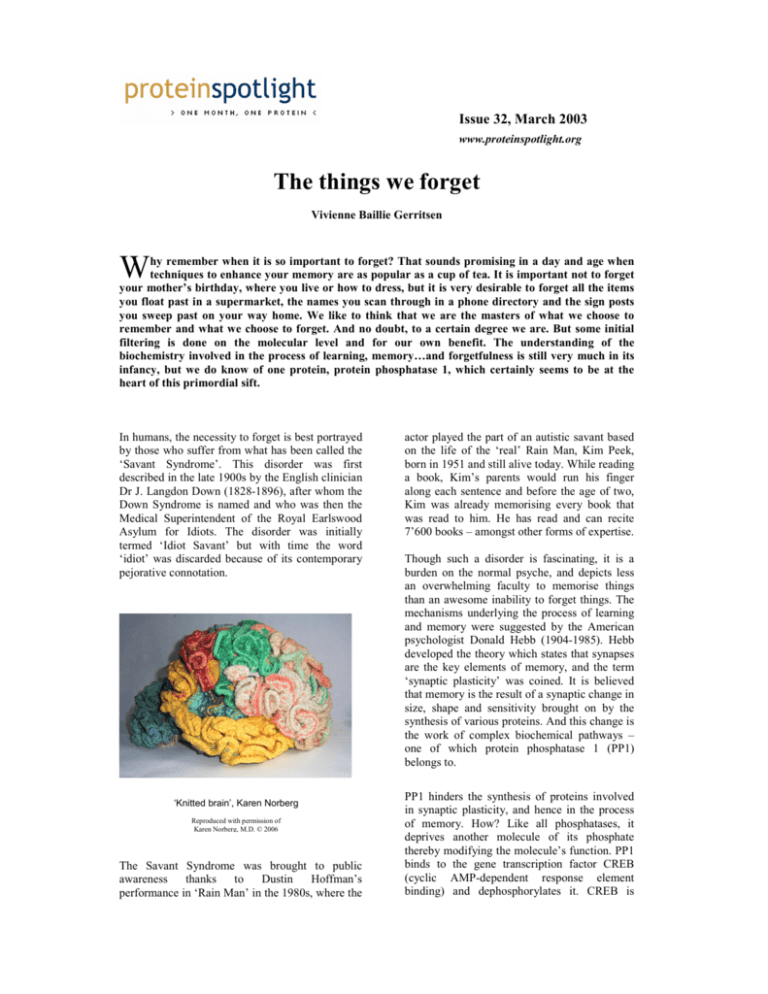Issue 32_The things we forget
advertisement

Issue 32, March 2003 www.proteinspotlight.org The things we forget Vivienne Baillie Gerritsen W hy remember when it is so important to forget? That sounds promising in a day and age when techniques to enhance your memory are as popular as a cup of tea. It is important not to forget your mother’s birthday, where you live or how to dress, but it is very desirable to forget all the items you float past in a supermarket, the names you scan through in a phone directory and the sign posts you sweep past on your way home. We like to think that we are the masters of what we choose to remember and what we choose to forget. And no doubt, to a certain degree we are. But some initial filtering is done on the molecular level and for our own benefit. The understanding of the biochemistry involved in the process of learning, memory…and forgetfulness is still very much in its infancy, but we do know of one protein, protein phosphatase 1, which certainly seems to be at the heart of this primordial sift. In humans, the necessity to forget is best portrayed by those who suffer from what has been called the ‘Savant Syndrome’. This disorder was first described in the late 1900s by the English clinician Dr J. Langdon Down (1828-1896), after whom the Down Syndrome is named and who was then the Medical Superintendent of the Royal Earlswood Asylum for Idiots. The disorder was initially termed ‘Idiot Savant’ but with time the word ‘idiot’ was discarded because of its contemporary pejorative connotation. ‘Knitted brain’, Karen Norberg Reproduced with permission of Karen Norberg, M.D. © 2006 The Savant Syndrome was brought to public awareness thanks to Dustin Hoffman’s performance in ‘Rain Man’ in the 1980s, where the actor played the part of an autistic savant based on the life of the ‘real’ Rain Man, Kim Peek, born in 1951 and still alive today. While reading a book, Kim’s parents would run his finger along each sentence and before the age of two, Kim was already memorising every book that was read to him. He has read and can recite 7’600 books – amongst other forms of expertise. Though such a disorder is fascinating, it is a burden on the normal psyche, and depicts less an overwhelming faculty to memorise things than an awesome inability to forget things. The mechanisms underlying the process of learning and memory were suggested by the American psychologist Donald Hebb (1904-1985). Hebb developed the theory which states that synapses are the key elements of memory, and the term ‘synaptic plasticity’ was coined. It is believed that memory is the result of a synaptic change in size, shape and sensitivity brought on by the synthesis of various proteins. And this change is the work of complex biochemical pathways – one of which protein phosphatase 1 (PP1) belongs to. PP1 hinders the synthesis of proteins involved in synaptic plasticity, and hence in the process of memory. How? Like all phosphatases, it deprives another molecule of its phosphate thereby modifying the molecule’s function. PP1 binds to the gene transcription factor CREB (cyclic AMP-dependent response element binding) and dephosphorylates it. CREB is subsequently inactivated and the transcription of a number of ‘memory’ genes is checked. PP1 must not always be active otherwise we would remember nothing at all. The German psychologist Hermann Ebbinghaus (1850-1909) was the first to study memory scientifically and showed – what we know instinctively – that we memorise information that is given in little spurts (distributed) much better than information given in one large gush (massed). This may remind some of wearisome, unending lectures followed by brain-cramming sessions before exams, none of which have left much of an impression on our memories. When PP1 is inhibited in mice, there is no difference between distributed learning and massed learning. This means that the gene transcription factor CREB is left to get on with its job unimpeded. It is thought that in the event of massed learning, the synthesis of PP1 increases, thereby checking CREB function and putting a constraint on what we learn and remember. In the event of distributed learning, PP1 synthesis does not have the chance to increase so sharply and its effect on CREB is weaker. What is more, the longer the interval between two sessions, the better the imprint of the memory, probably because the level of PP1 decreases and CREB is given time to settle and function as it should. So, in effect, our memorising faculties depend on a certain PP1 threshold. More to the point, when PP1 is inhibited after the memory process, the memory is long lasting, which means that in its natural state, PP1 has a direct effect on forgetfulness. So memory decline as we get older is probably due, not to the wear and tear of our brain as we could easily imagine or, for that matter, to a lack of space, but to an increasing amount of PP1. As a consequence, it should not be such a task to conjure up a memory enhancing therapy. But it is. PP1 is ‘just’ a phosphatase. Phosphorylation and dephosphorylation are among the most common biochemical processes and are used as on/off switches in many biological instances. Inhibiting PP1 could have drastic effects – its clients are not only the gene transcription factor CREB. However, the knowledge of PP1 function does shed light on the very complex path of learning, memory and forgetfulness and could pave the way to subtle therapies in the event of Alzheimer’s disease for instance, brain traumas and indeed the withering of our memories due to the simple passing of time. Cross-references to Swiss-Prot Protein phosphatase PP1-alpha, Homo sapiens (Human) : P08129 Protein phosphatase PP1-alpha, Mus musculus (mouse) : P08129 Protein phosphatase PP1-alpha, Rattus norvegicus (Rat) : P08129 Protein phosphatase PP1-alpha, Oryctolagus cuniculus (Rabbit) : P08129 Protein phosphatase PP1-beta, Homo sapiens (Human) : P37140 Protein phosphatase PP1-gamma, Homo sapiens (Human) : P36873 Protein phosphatase PP1-gamma, Mus musculus (Mouse) : P37139 Protein phosphatase PP1-gamma, Rattus norvegicus (Rat) : P37139 References 1. Silva A.J., Josselyn S.A. The molecules of forgetfulness Nature 418:929-930(2002) PMID: 12198533 2. Sweatt J.D. Memory mechanisms: the yin and yang of protein phosphorylation Curr. Biol. 11:R391-R394(2001) PMID: 11378403 3. Gross M. Mysteries of the memory molecules http://www.chemsoc.org/chembytes/ezine/2002/gross_dec02.htm Protein Spotlight (ISSN 1424-4721), http://www.proteinspotlight.org, is published by the Swiss-Prot group at the Swiss Institute of Bioinformatics (SIB). Authorization to photocopy or reproduce this article for internal or personal use is granted by the SIB provided its content is not modified. Please enquire at spotlight@isb-sib.ch for redistribution or commercial usage.

![The Vector Form of Coulomb’s Law of Force [ ]](http://s2.studylib.net/store/data/010286221_1-1ed68ddbead41515f19ce45cc0c2c134-300x300.png)





